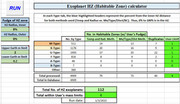I've developed a more comprehensive Excel program (VBA) to categorize all the exoplanets by stellar types. We are just short of 5000 known exoplanets, and it won't be that long we'll be at 10k. 
The only requirement for a user is to cut and paste the data from the catalog at exoplanet.eu. Once done, only the "Run" button needs to be clicked. [Of course, Users can change the parameters shown in the green highlight in column A.]
The program allows the user to increase or decrease the HZ to help with the benefits from atmospheres, for instance. It also allows the User to set the exoplanet mass range to count these separately, also by stellar type.
Not shown are the actual planets listed for each stellar class. These have their own tabs, which means any normal Excel sorting, etc. can be performed by stellar class.
Here are the latest results:

The only requirement for a user is to cut and paste the data from the catalog at exoplanet.eu. Once done, only the "Run" button needs to be clicked. [Of course, Users can change the parameters shown in the green highlight in column A.]
The program allows the user to increase or decrease the HZ to help with the benefits from atmospheres, for instance. It also allows the User to set the exoplanet mass range to count these separately, also by stellar type.
Not shown are the actual planets listed for each stellar class. These have their own tabs, which means any normal Excel sorting, etc. can be performed by stellar class.
Here are the latest results:



